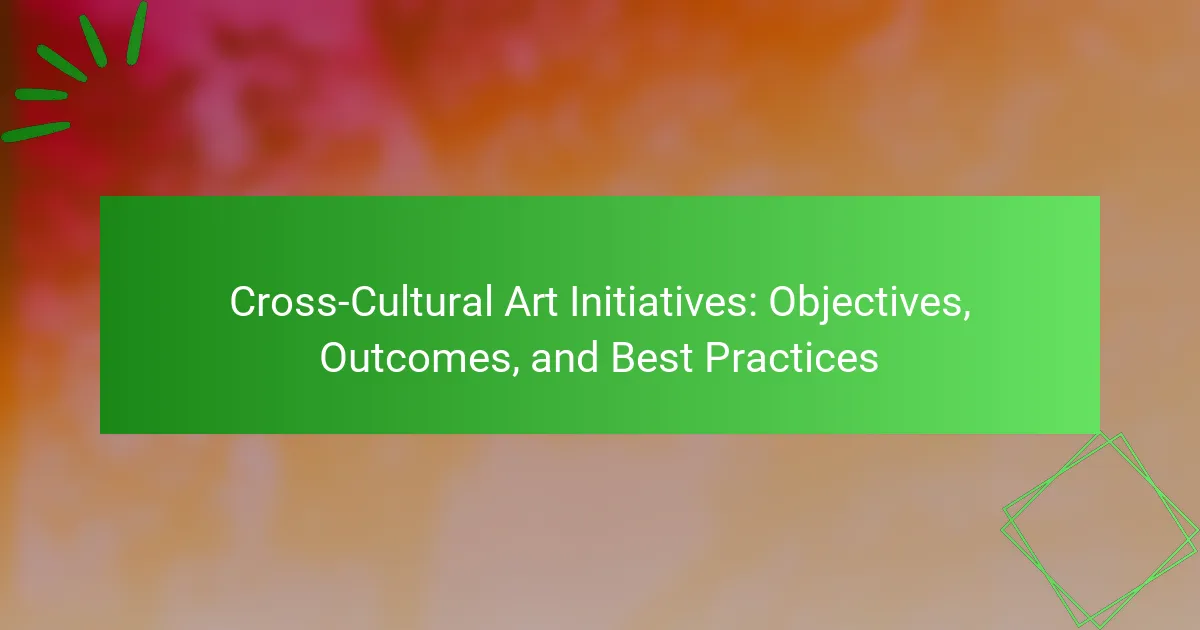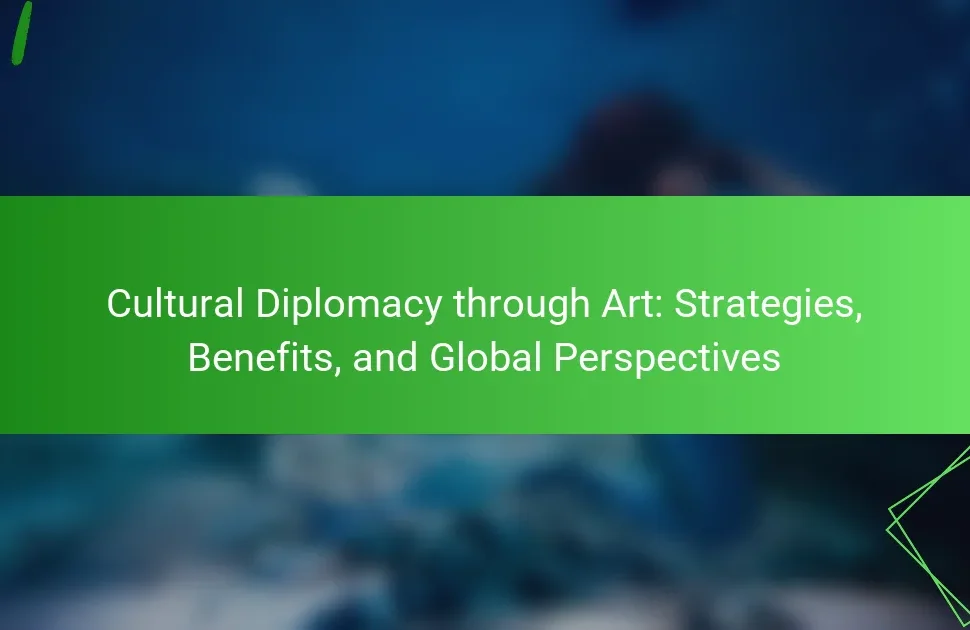Cross-cultural art initiatives enhance community engagement and promote cultural appreciation while addressing social issues. They aim to foster dialogue, challenge stereotypes, and preserve cultural heritage. Successful initiatives rely on collaboration, cultural sensitivity, and clear objectives. However, challenges like funding limitations and logistical complexities can impact their effectiveness and sustainability.
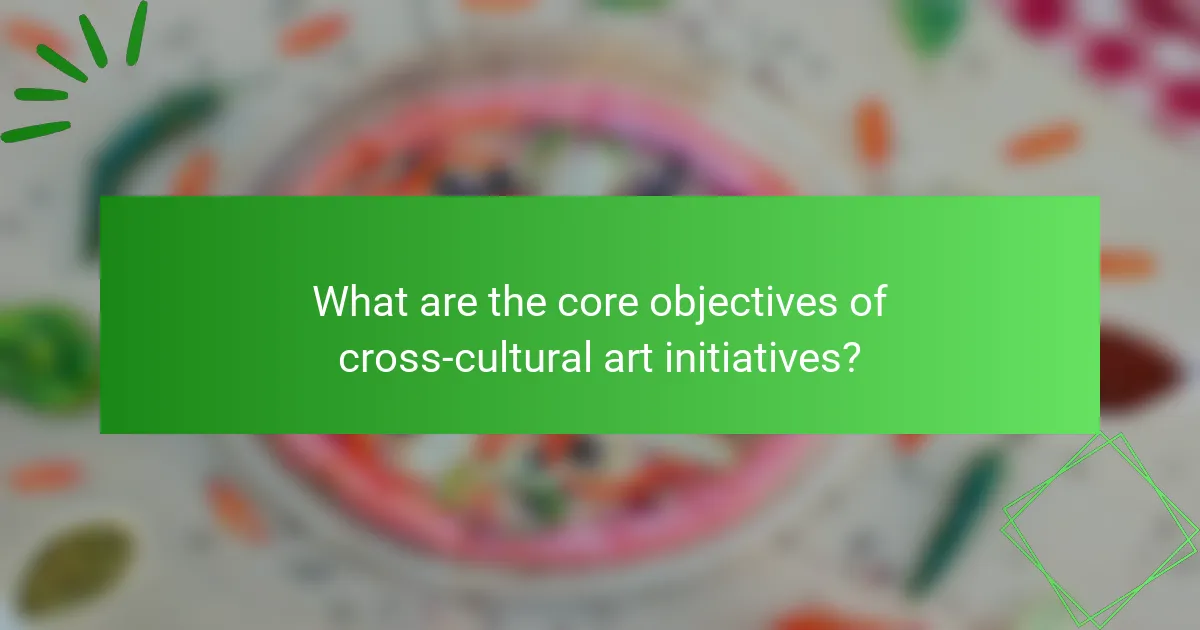
What are the core objectives of cross-cultural art initiatives?
Cross-cultural art initiatives aim to foster understanding, collaboration, and appreciation among diverse cultures. They seek to promote dialogue, enhance social cohesion, and challenge stereotypes through artistic expression. Key objectives include community engagement, educational outreach, and the preservation of cultural heritage. These initiatives often result in enriched cultural exchanges, increased visibility for underrepresented artists, and the creation of inclusive spaces for creativity.
How do these objectives vary across different cultures?
Objectives of cross-cultural art initiatives vary significantly across cultures, reflecting unique values and social contexts. In some cultures, these initiatives aim to promote social cohesion and community identity. In others, they focus on economic development through tourism or cultural exchange.
For example, in Western cultures, art initiatives often emphasize individual expression and innovation. In contrast, many Indigenous cultures prioritize storytelling and tradition preservation through collective artistic practices.
Additionally, the objectives can shift based on societal needs. For instance, initiatives in conflict-affected regions may prioritize healing and reconciliation, while those in urban areas might focus on urban revitalization and public engagement.
Understanding these variations is crucial for developing effective cross-cultural art initiatives that resonate with local communities.
Which stakeholders are involved in achieving these objectives?
Key stakeholders in cross-cultural art initiatives include artists, cultural organizations, local communities, government agencies, and sponsors. Each plays a vital role in achieving objectives through collaboration and resource sharing. Artists contribute creative vision, while cultural organizations facilitate project execution. Local communities provide context and engagement, government agencies offer support and funding, and sponsors supply financial resources. Their combined efforts lead to successful outcomes and best practices in cross-cultural art initiatives.
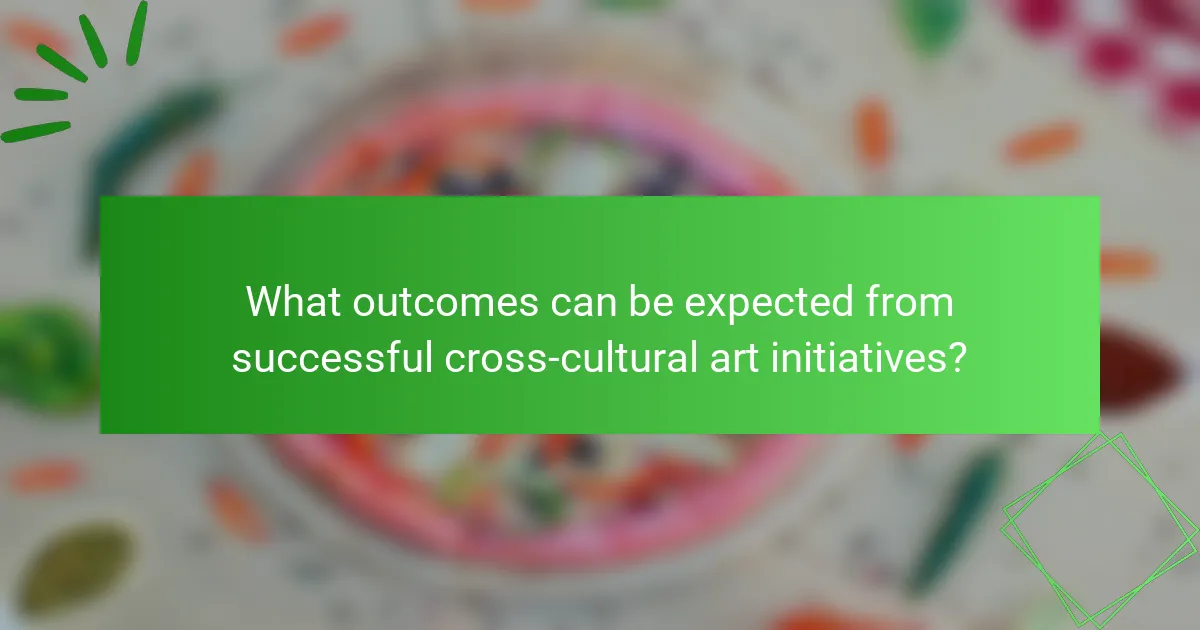
What outcomes can be expected from successful cross-cultural art initiatives?
Successful cross-cultural art initiatives yield enhanced community engagement, cultural exchange, and social cohesion. They foster mutual understanding and respect among diverse groups. As a result, participants often experience personal growth and increased creativity. Collaborative projects can lead to innovative art forms that reflect multiple perspectives, enriching the cultural landscape.
How do these outcomes impact local communities?
Cross-cultural art initiatives positively impact local communities by fostering social cohesion and cultural exchange. They enhance community identity and pride while providing platforms for diverse voices. These initiatives often lead to economic benefits through increased tourism and local engagement. Additionally, they promote education and awareness of different cultures, enriching the community’s social fabric.
What metrics are used to evaluate the success of these initiatives?
Metrics used to evaluate the success of cross-cultural art initiatives include participant engagement, audience reach, and impact on community cohesion. These metrics provide insights into the effectiveness of the initiatives in fostering cultural exchange and artistic collaboration.
| Metric | Description |
|—————————-|——————————————————-|
| Participant Engagement | Number of artists and community members involved |
| Audience Reach | Total attendees at events and exhibitions |
| Community Impact | Changes in social dynamics and cultural understanding |
| Artistic Quality | Assessment of artistic merit and innovation |
| Feedback and Surveys | Participant satisfaction and qualitative insights |
| Sustainability | Long-term viability and ongoing community involvement |
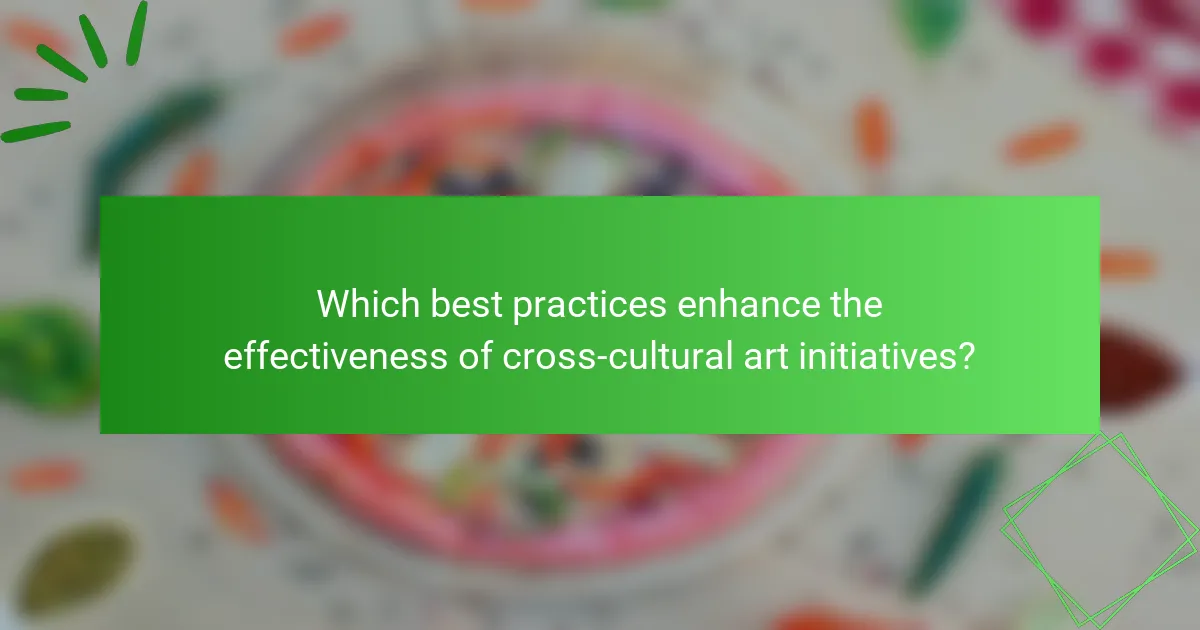
Which best practices enhance the effectiveness of cross-cultural art initiatives?
Effective cross-cultural art initiatives thrive on collaboration, cultural sensitivity, and community engagement. Key best practices include establishing clear objectives, fostering inclusive dialogue, and integrating local artists. Additionally, evaluating outcomes through feedback ensures initiatives remain relevant and impactful. Emphasizing shared cultural narratives enhances understanding and appreciation among diverse audiences.
What role does community engagement play in these practices?
Community engagement is vital for the success of cross-cultural art initiatives. It fosters collaboration, enhances cultural exchange, and builds trust among diverse groups. Engaging local communities ensures that art practices reflect their values and narratives, leading to more meaningful outcomes. Additionally, community involvement can increase participation and support for initiatives, resulting in sustainable projects. By prioritizing community voices, these initiatives can address unique local challenges and celebrate diverse cultural heritages.
How can technology facilitate cross-cultural collaboration in art?
Technology enhances cross-cultural collaboration in art by providing platforms for connection and creativity. Digital tools facilitate communication, enabling artists from diverse backgrounds to share ideas and collaborate on projects. Virtual galleries and social media platforms allow for broader exposure and engagement, fostering understanding and appreciation of different cultures. Additionally, online workshops and webinars promote skill sharing and cultural exchange, enriching the artistic landscape. Collaborative projects can leverage technology to unite artists across geographical boundaries, creating innovative works that reflect a blend of cultural influences.
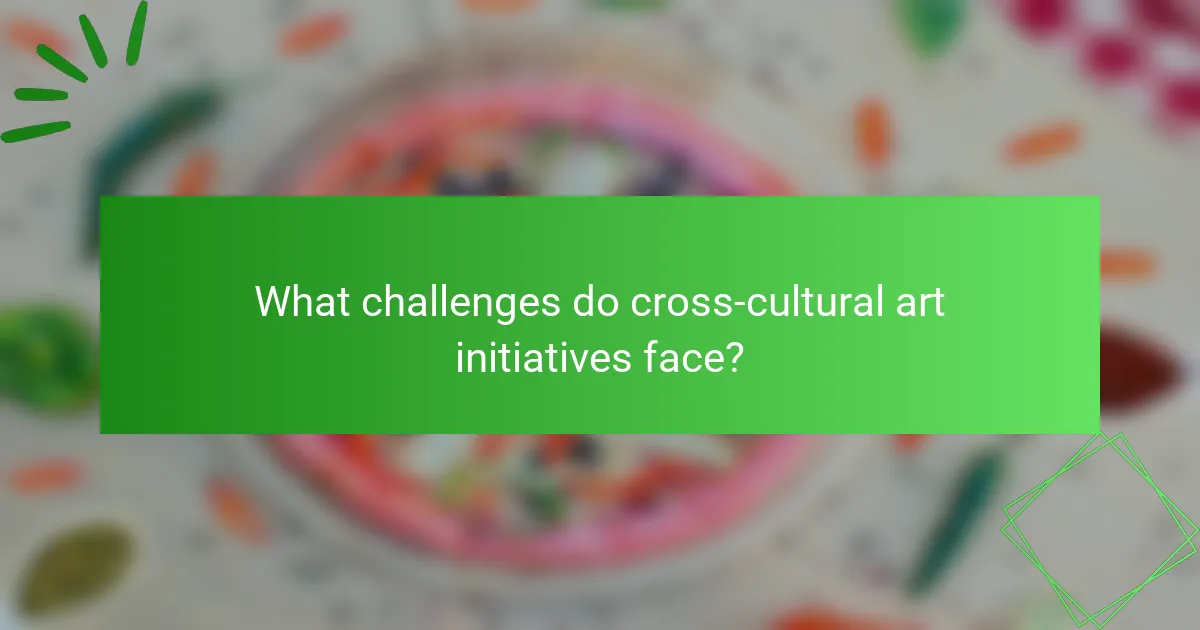
What challenges do cross-cultural art initiatives face?
Cross-cultural art initiatives face several challenges, including cultural misunderstandings, funding limitations, and logistical complexities. These issues can hinder collaboration and limit the impact of artistic projects.
Cultural misunderstandings arise when participants misinterpret artistic expressions or cultural references. This can lead to miscommunication and conflict. Funding limitations often restrict the scope and sustainability of initiatives, making it difficult to achieve long-term goals.
Logistical complexities can include coordinating between different time zones, languages, and administrative requirements. These factors can complicate planning and execution, resulting in delays or incomplete projects.
Addressing these challenges requires clear communication, adequate resources, and a commitment to cultural sensitivity.
How do cultural sensitivities affect project implementation?
Cultural sensitivities significantly influence project implementation by shaping community engagement and acceptance. Understanding local customs, values, and communication styles enhances collaboration and reduces conflicts. For cross-cultural art initiatives, acknowledging these sensitivities leads to more effective and meaningful outcomes. Projects that respect cultural nuances often see increased participation and support, fostering a sense of ownership among community members.
What funding sources are available to support these initiatives?
Various funding sources support cross-cultural art initiatives, including government grants, private foundations, corporate sponsorships, crowdfunding platforms, and international cultural exchange programs. These sources provide financial resources for projects that enhance cultural understanding and artistic collaboration. Government grants often focus on community development, while private foundations may target specific artistic disciplines. Corporate sponsorships can offer significant funding in exchange for brand visibility. Crowdfunding allows artists to engage with their audience directly for support. International programs may provide funding for cross-border collaborations, fostering global artistic dialogue.
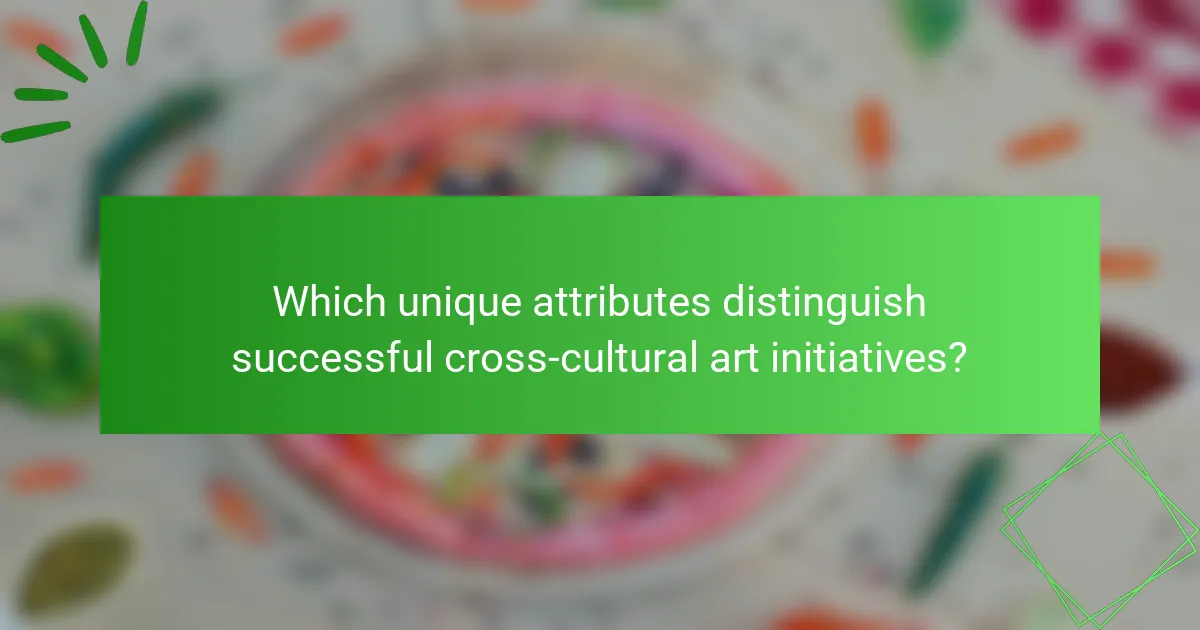
Which unique attributes distinguish successful cross-cultural art initiatives?
Successful cross-cultural art initiatives are distinguished by their ability to foster genuine collaboration, promote cultural exchange, and address social issues. These initiatives often emphasize community engagement, ensuring diverse voices are represented. Unique attributes include adaptability to local contexts, innovative use of technology, and sustainability in practice. As a result, they create lasting impacts on both participants and audiences, enhancing mutual understanding and appreciation across cultures.
How do artistic styles influence cross-cultural collaboration?
Artistic styles significantly enhance cross-cultural collaboration by fostering understanding and creativity. They enable diverse perspectives, leading to innovative solutions and shared experiences. For instance, blending traditional and contemporary art styles can create unique cultural expressions that resonate across borders. This synergy often results in successful initiatives that promote cultural exchange and appreciation. Furthermore, collaborative art projects can break down barriers, encouraging dialogue and cooperation among different cultural groups.
What case studies exemplify innovative approaches in this field?
Case studies showcasing innovative approaches in cross-cultural art initiatives include the “Art for Social Change” project, which enhances community engagement through collaborative art-making. Another notable example is “Cultural Exchange Program,” fostering dialogue between artists from diverse backgrounds, resulting in unique exhibitions. These initiatives emphasize the importance of cultural understanding and shared experiences, demonstrating how art can bridge social divides.
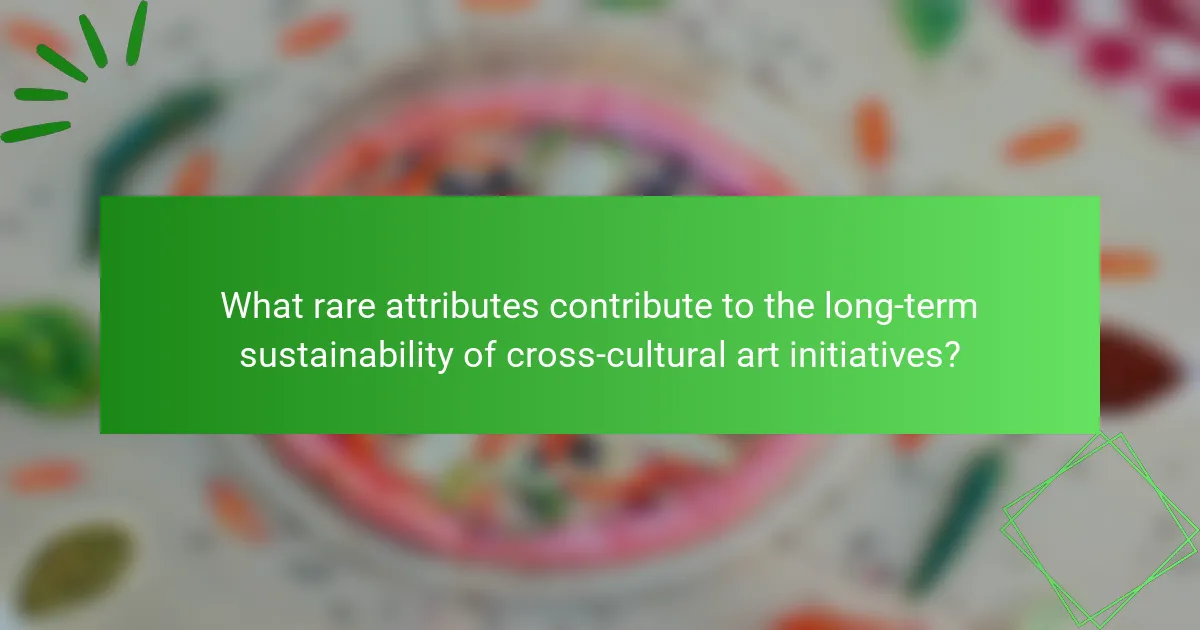
What rare attributes contribute to the long-term sustainability of cross-cultural art initiatives?
Rare attributes that contribute to the long-term sustainability of cross-cultural art initiatives include community engagement, adaptability, and cultural relevance. Community engagement fosters local ownership and participation, ensuring initiatives resonate with the audience. Adaptability allows projects to evolve based on feedback and changing circumstances, enhancing resilience. Cultural relevance ensures that the art reflects and respects local traditions, promoting ongoing interest and support. These attributes collectively strengthen the initiatives, making them more impactful and sustainable over time.
How can these initiatives adapt to changing global dynamics?
Cross-cultural art initiatives can adapt to changing global dynamics by fostering collaboration and inclusivity. They should integrate local perspectives, utilize digital platforms, and respond to socio-political shifts. Emphasizing sustainability and community engagement enhances relevance. For example, initiatives can leverage technology to reach broader audiences, ensuring diverse voices are represented. Adapting to global challenges, such as climate change, can also redefine artistic expressions and themes, promoting resilience and awareness.
What lessons can be learned from unsuccessful initiatives?
Unsuccessful cross-cultural art initiatives highlight key lessons for future projects. They often fail due to inadequate understanding of cultural contexts, lack of community engagement, and insufficient evaluation metrics.
1. Emphasize cultural sensitivity: Projects should prioritize understanding the cultural backgrounds of participants to foster genuine connections.
2. Engage local communities: Involving local artists and stakeholders ensures initiatives resonate with the target audience and address their needs.
3. Establish clear objectives: Defining measurable goals helps assess the success of initiatives and informs future efforts.
4. Implement thorough evaluations: Continuous feedback and assessment can identify weaknesses and areas for improvement throughout the initiative.
Learning from these failures can enhance the effectiveness of future cross-cultural art initiatives.
What are the best practices for ensuring ongoing community involvement?
Engaging the community in cross-cultural art initiatives requires consistent strategies. Foster relationships through regular workshops and events, ensuring diverse voices are heard. Utilize social media for outreach and feedback, promoting transparency and inclusivity. Establish partnerships with local organizations to broaden participation and resources. Measure engagement through surveys to adapt and improve initiatives effectively.
